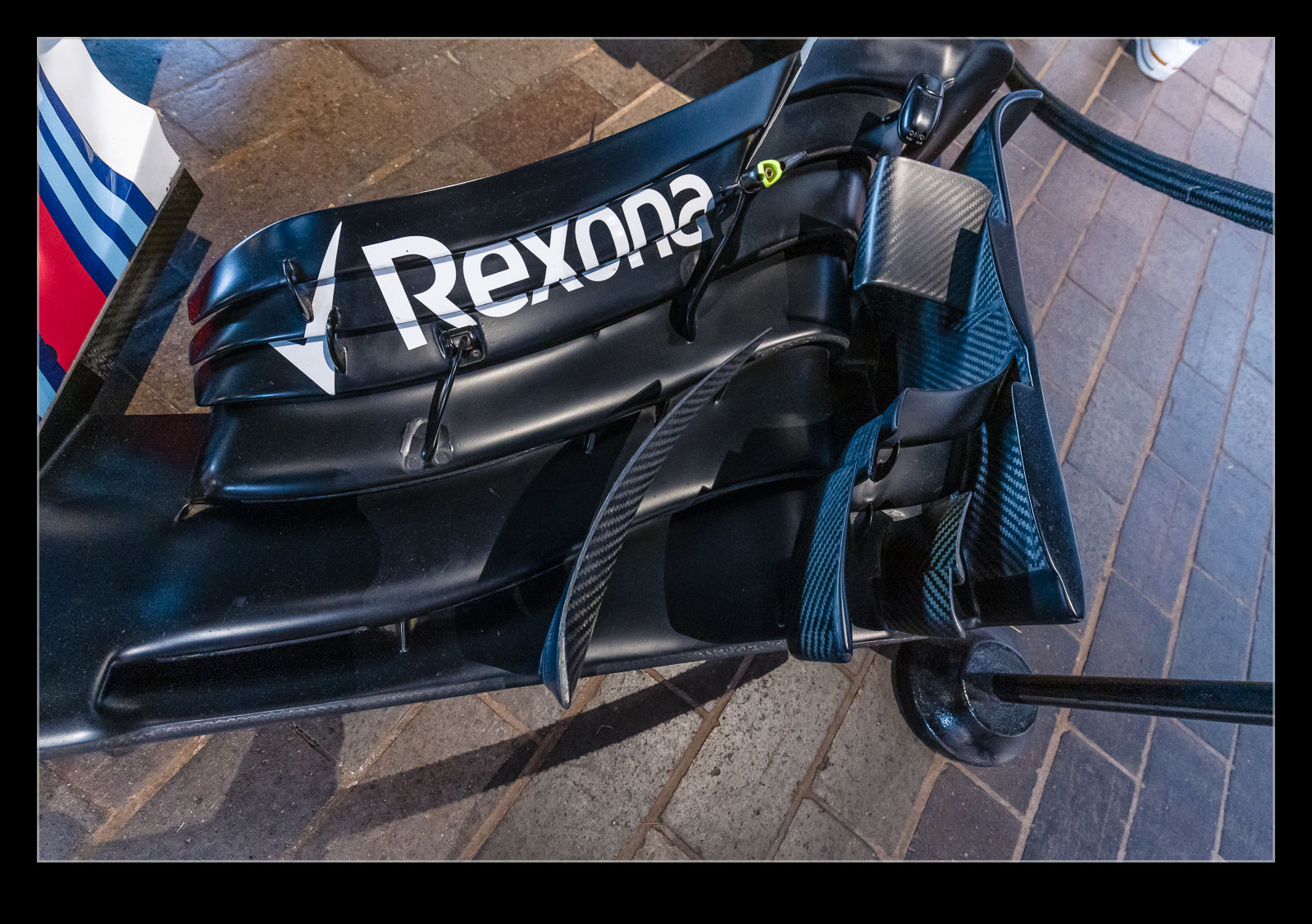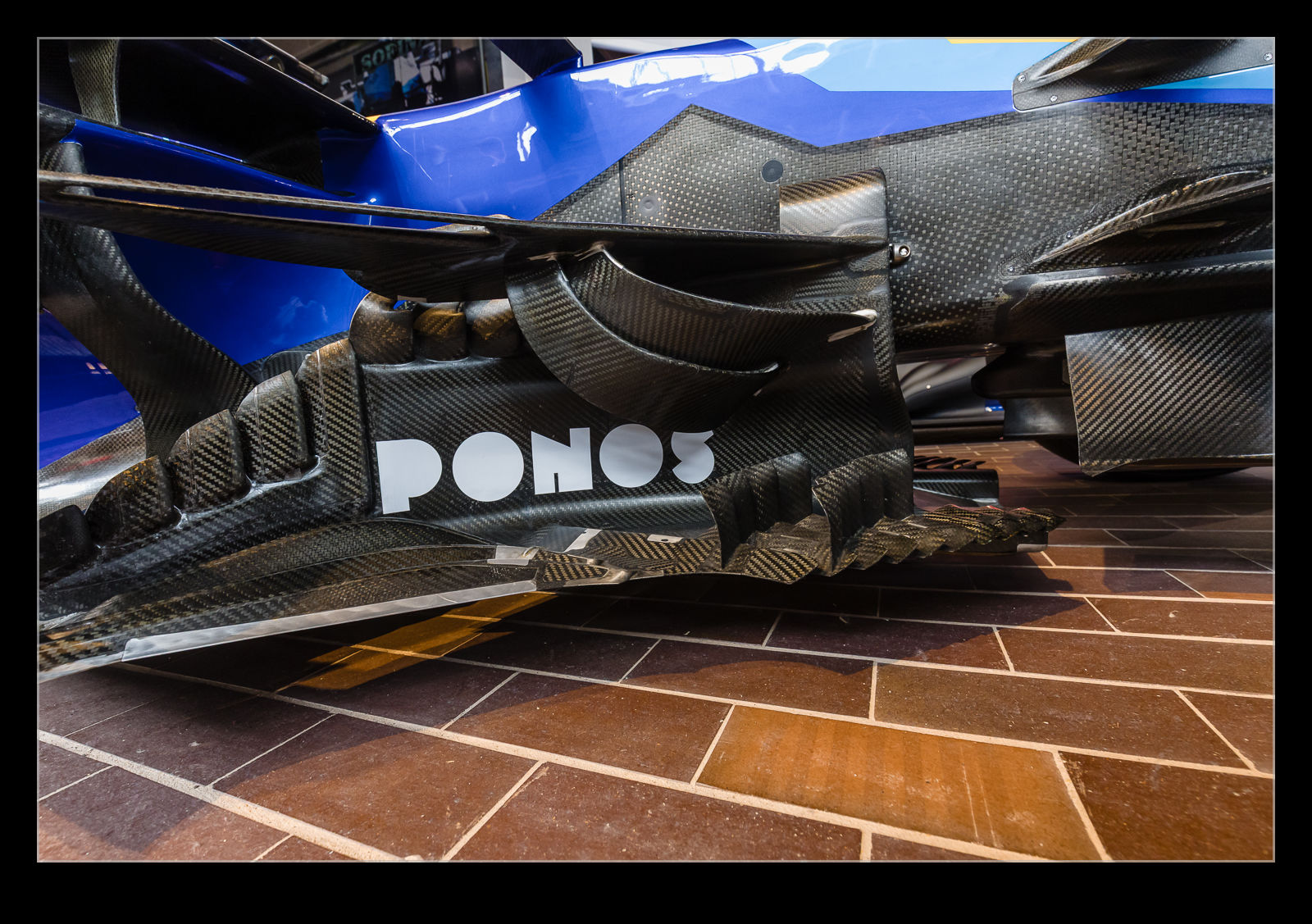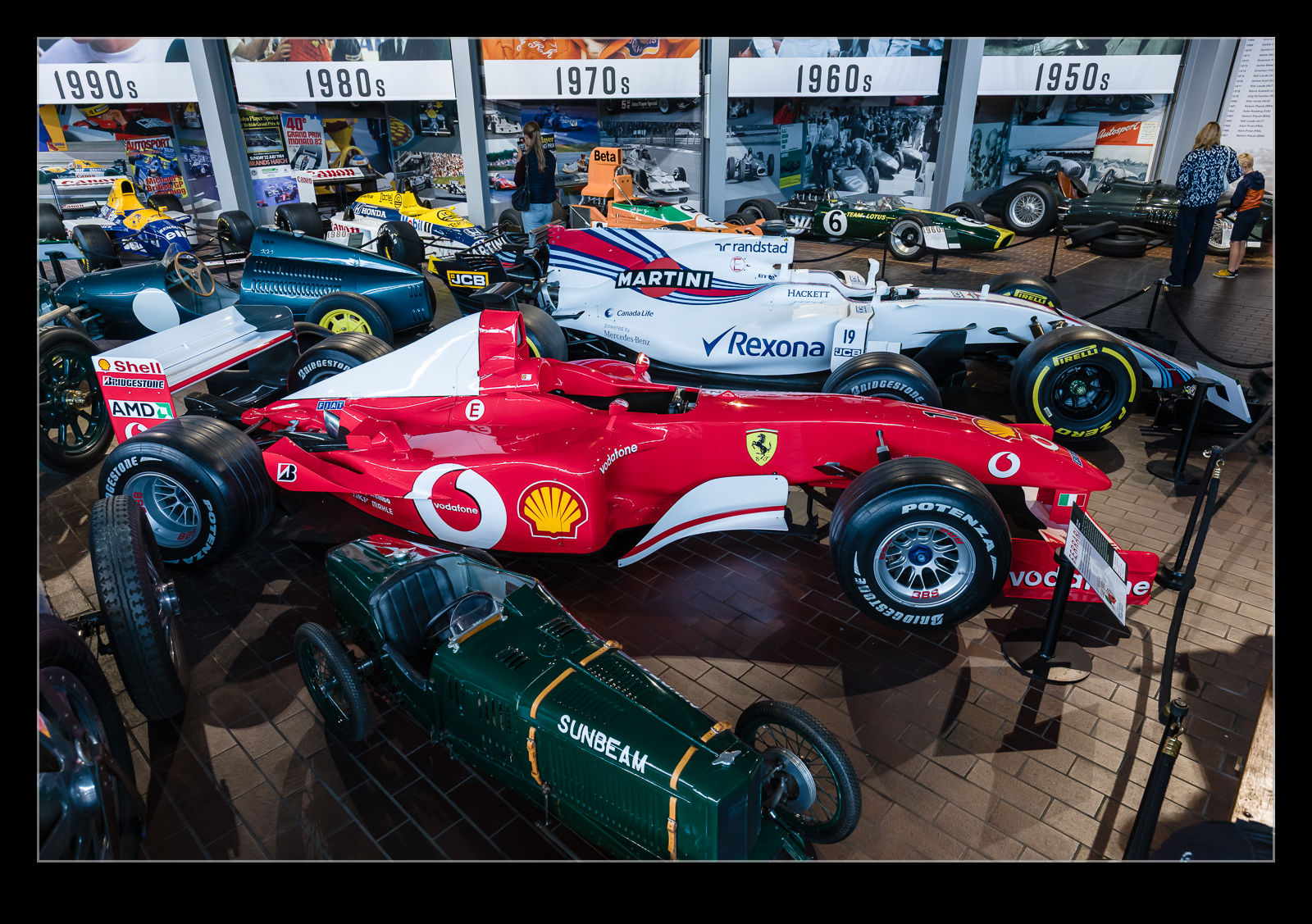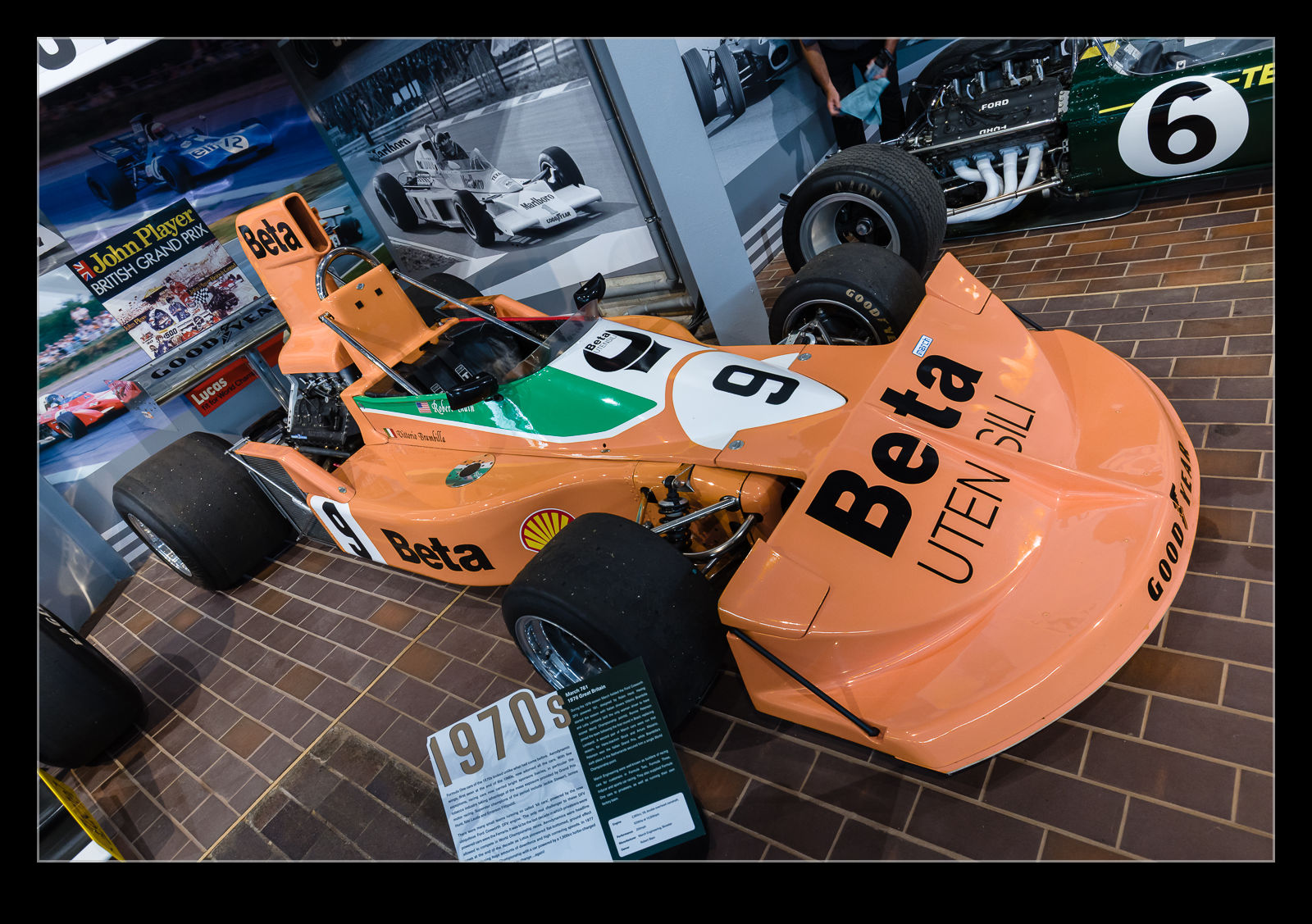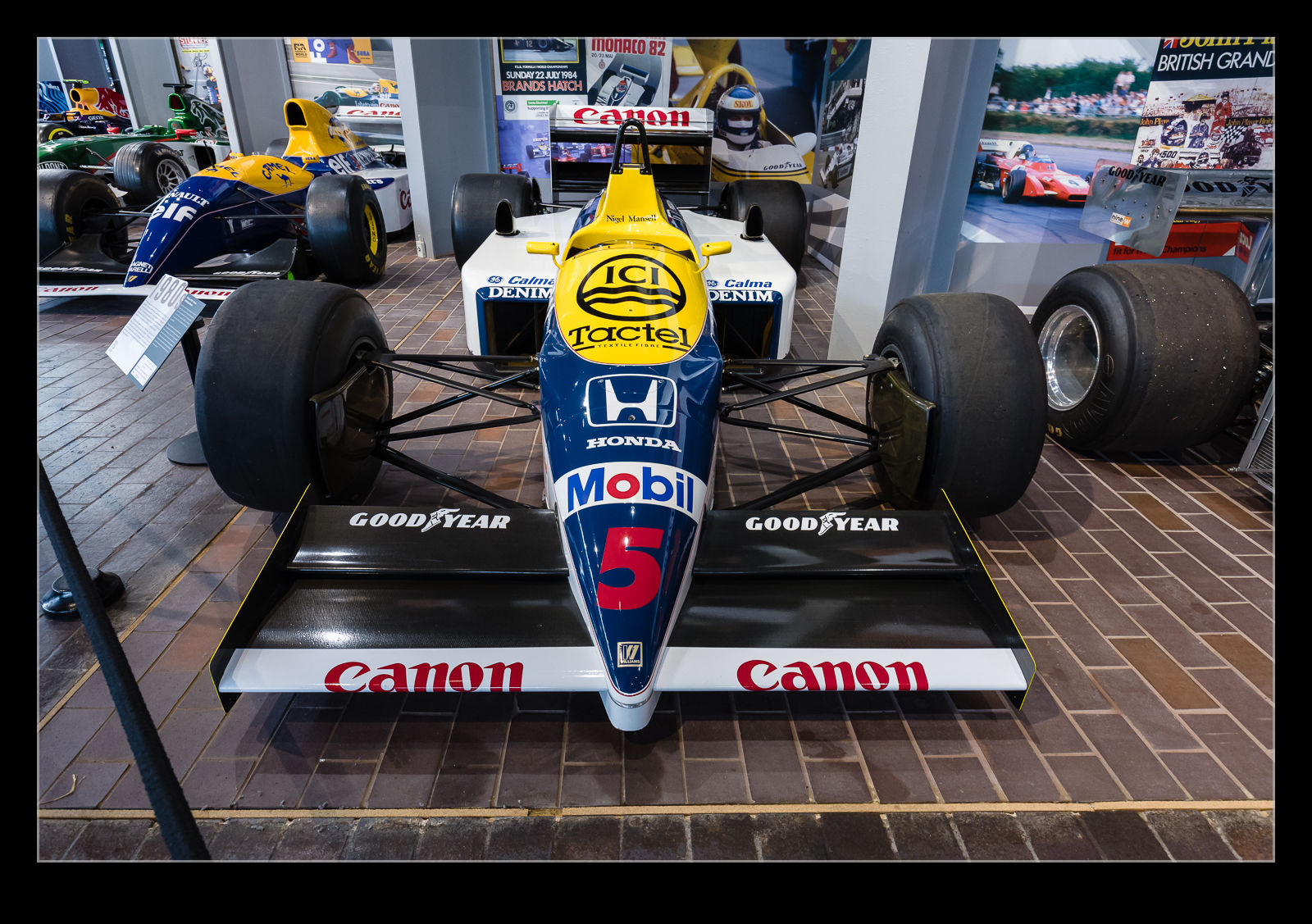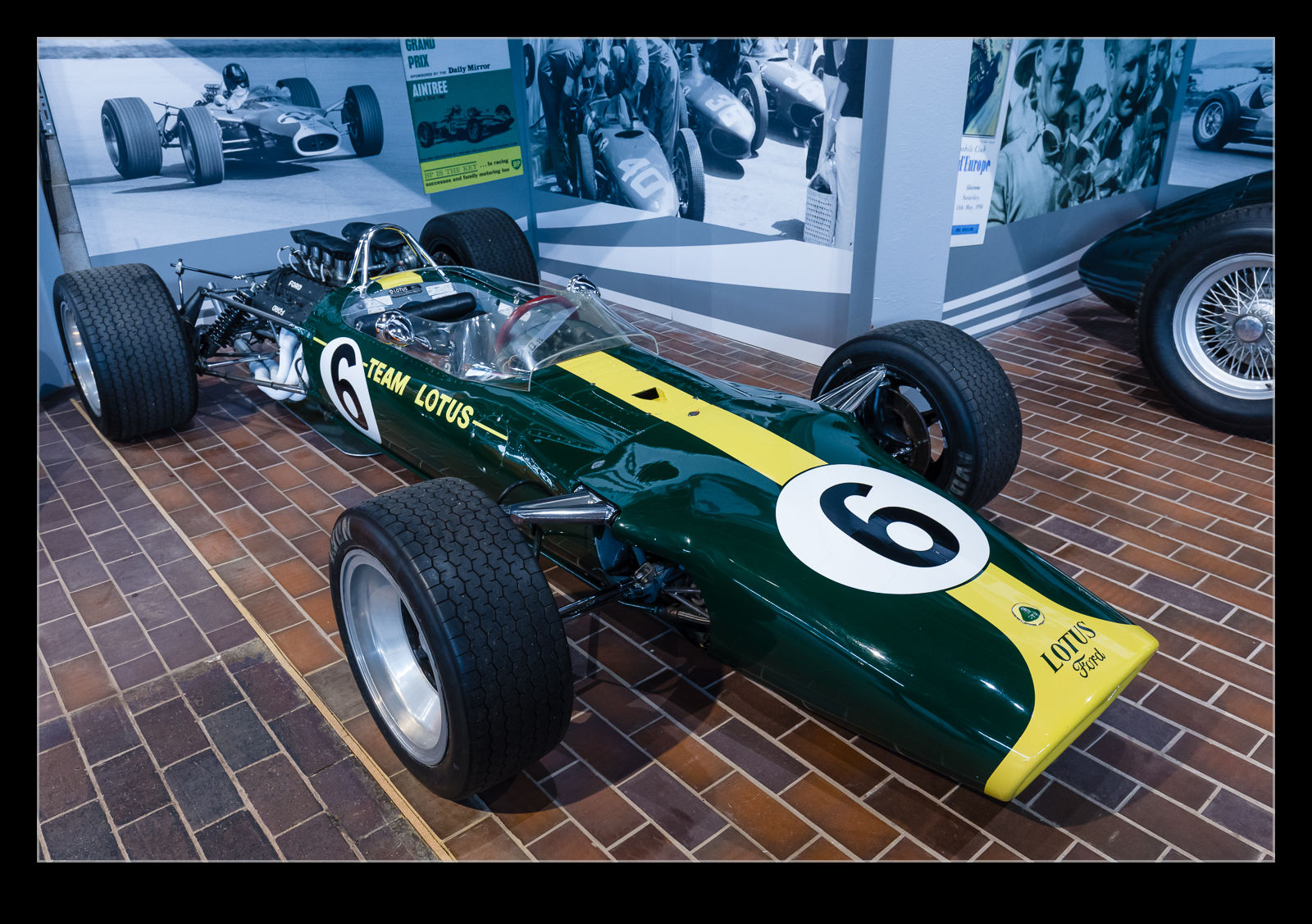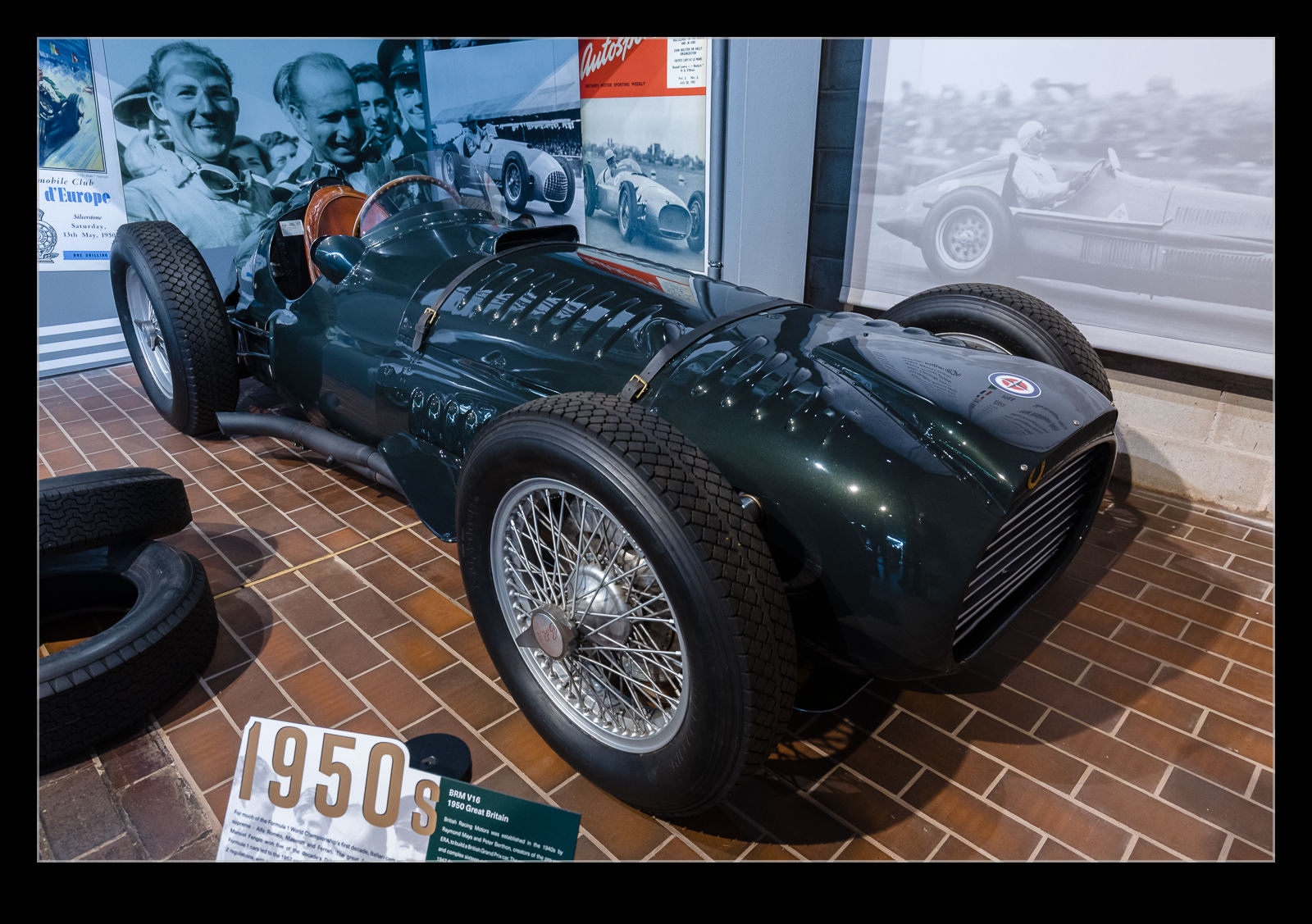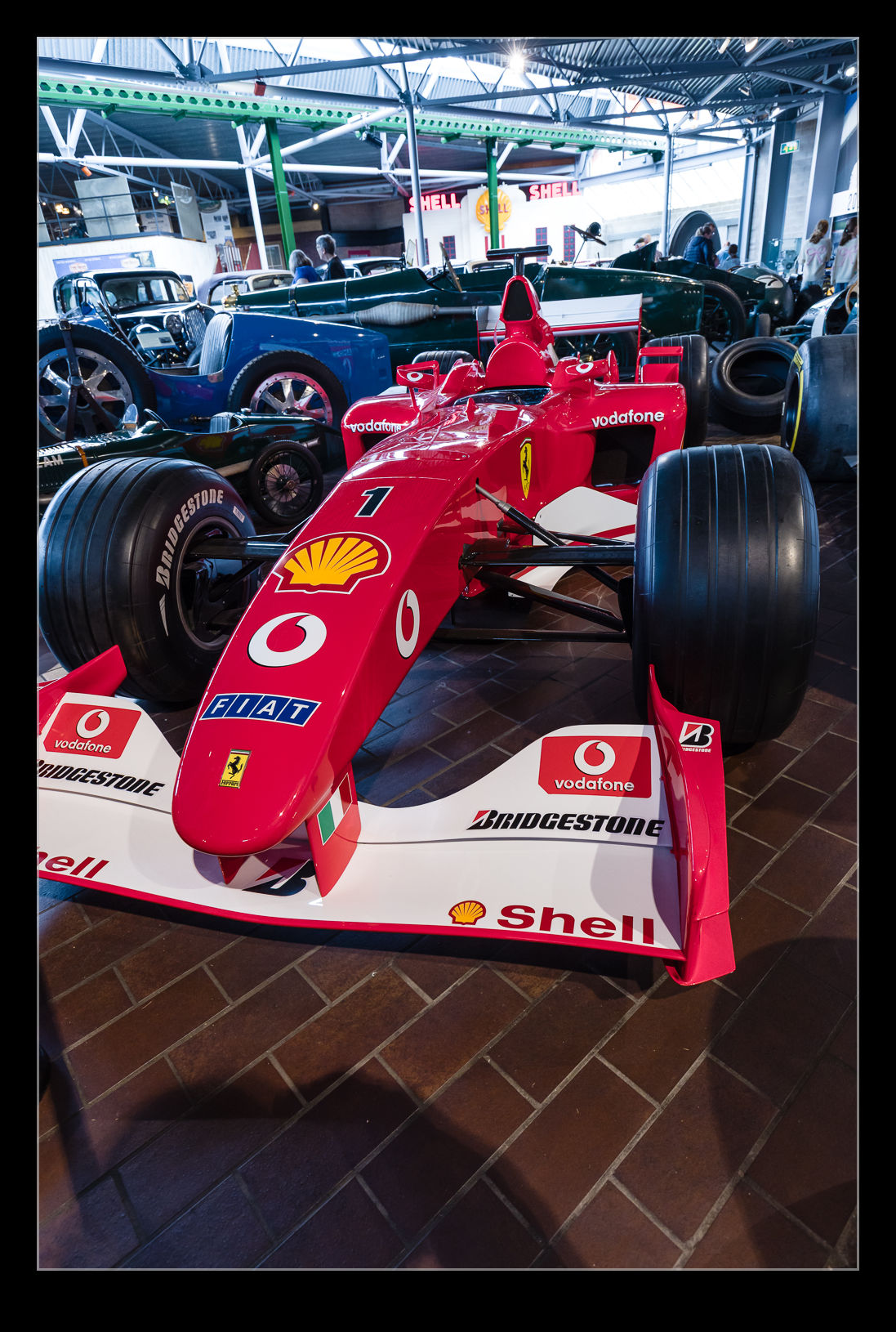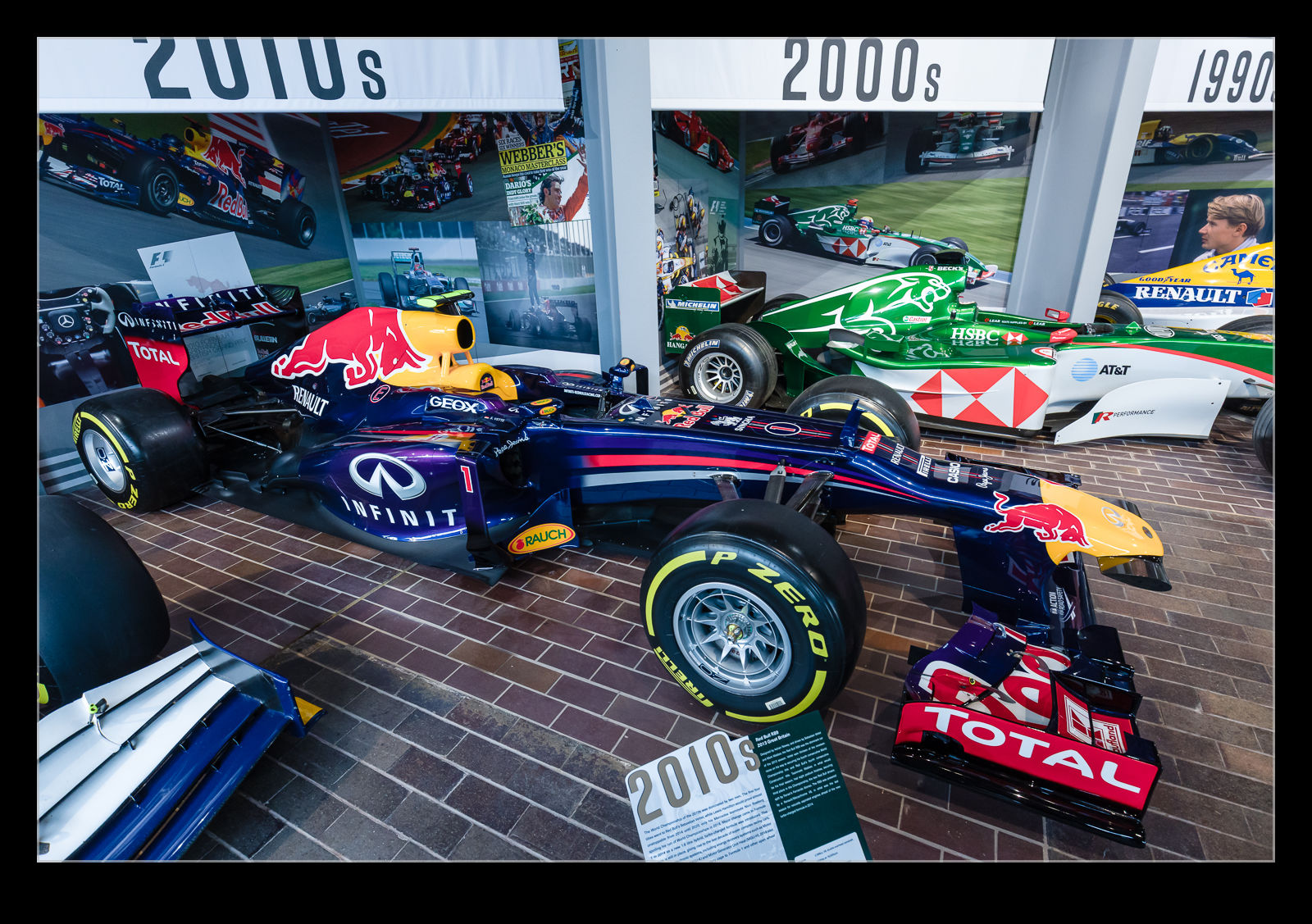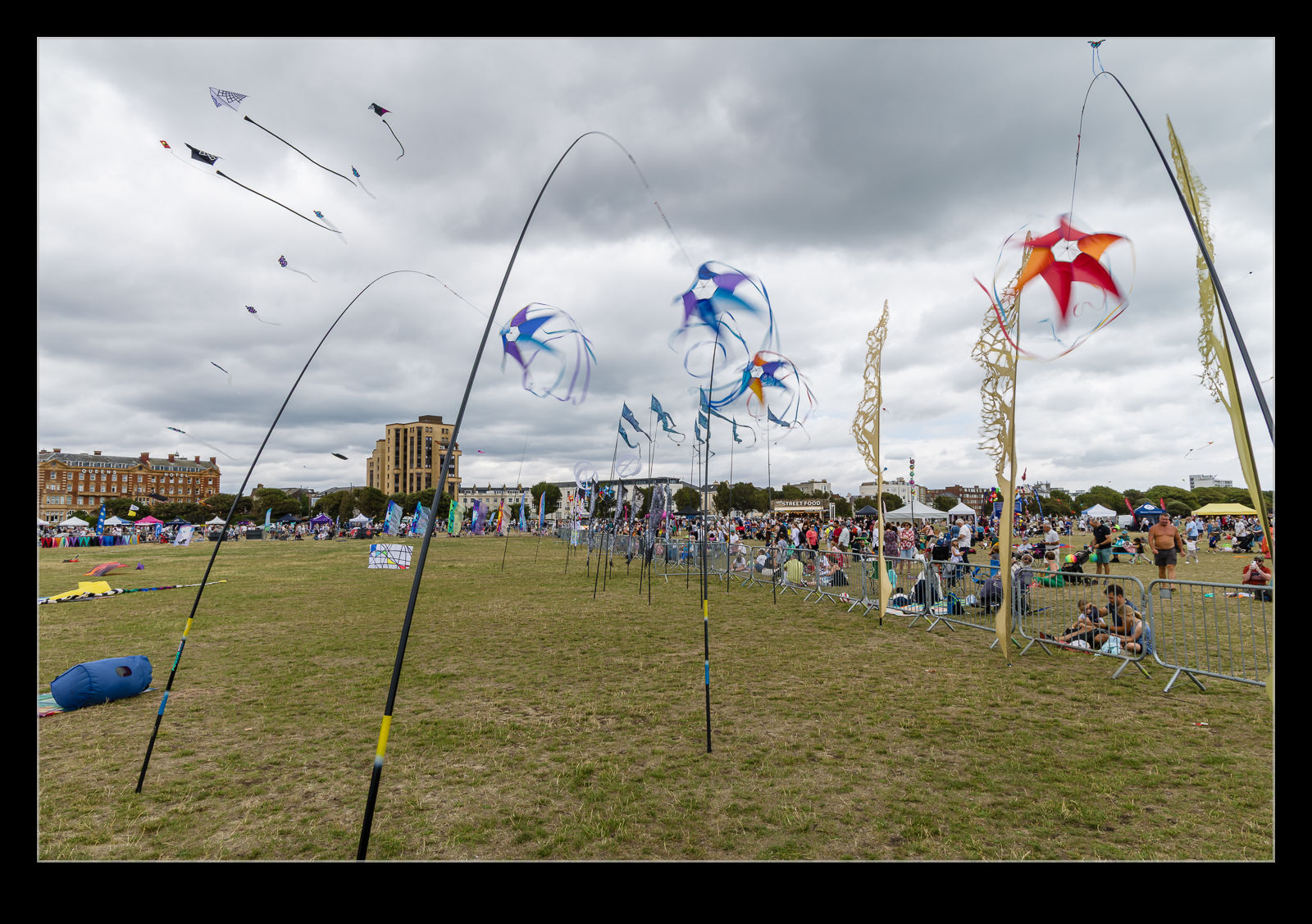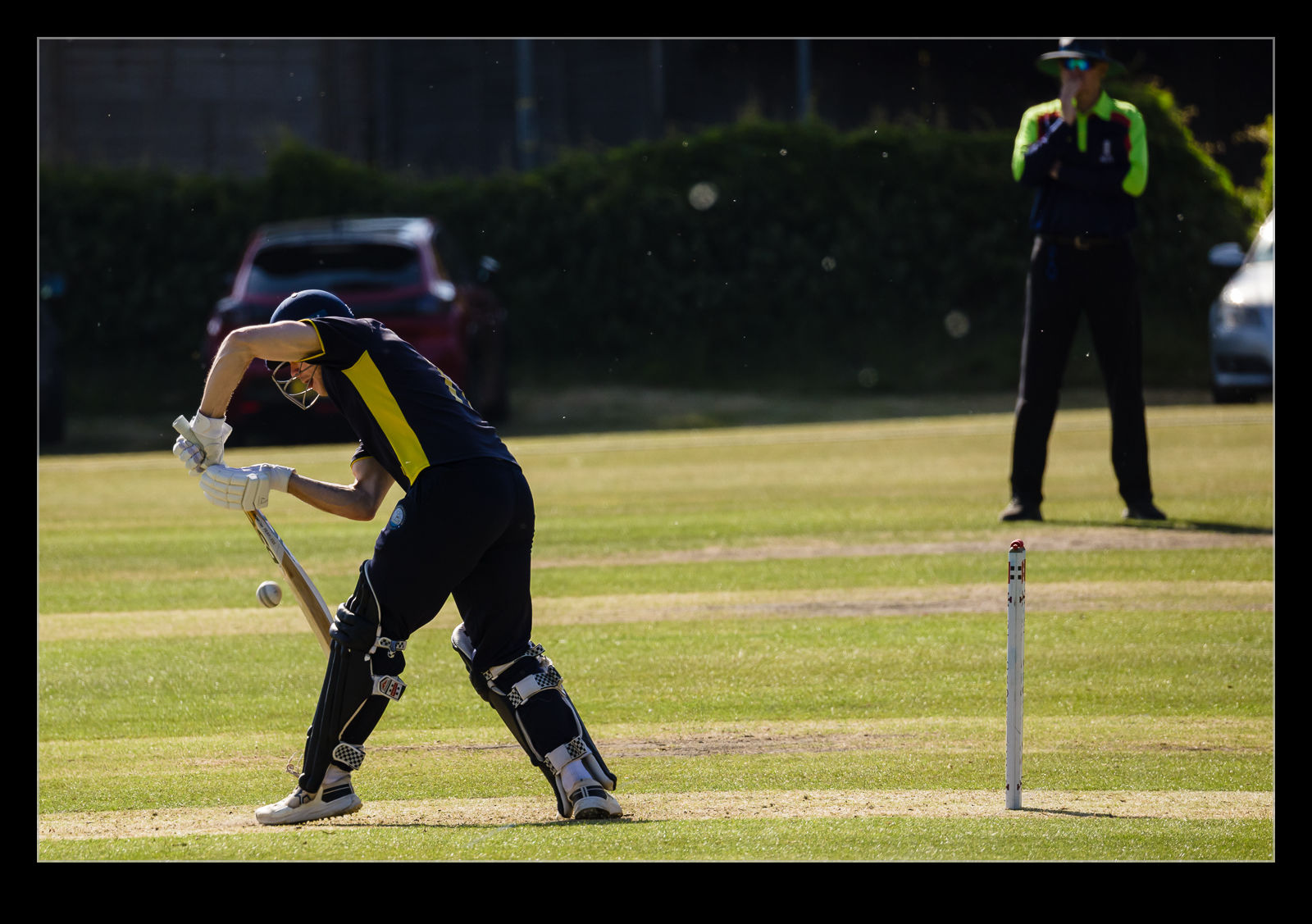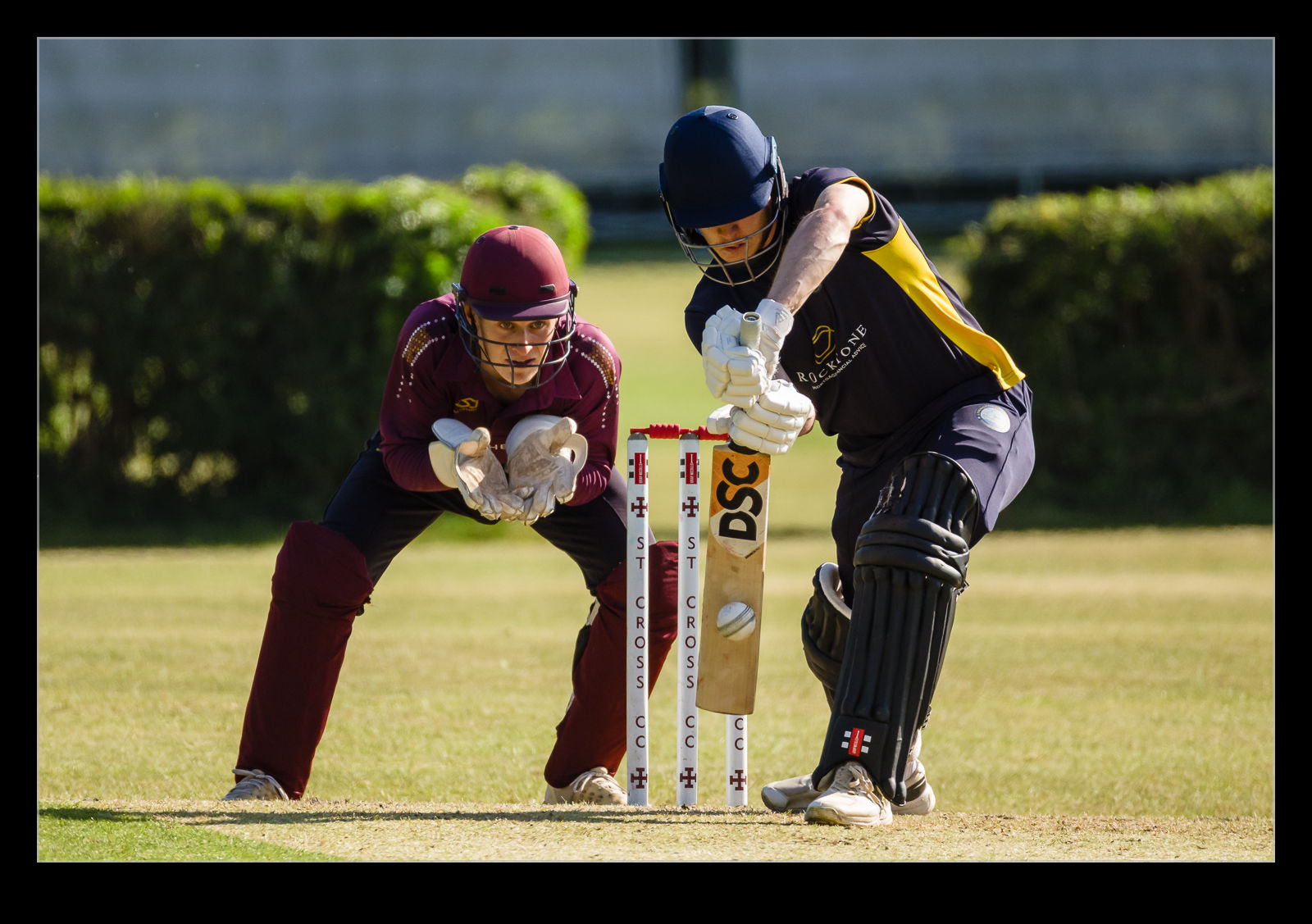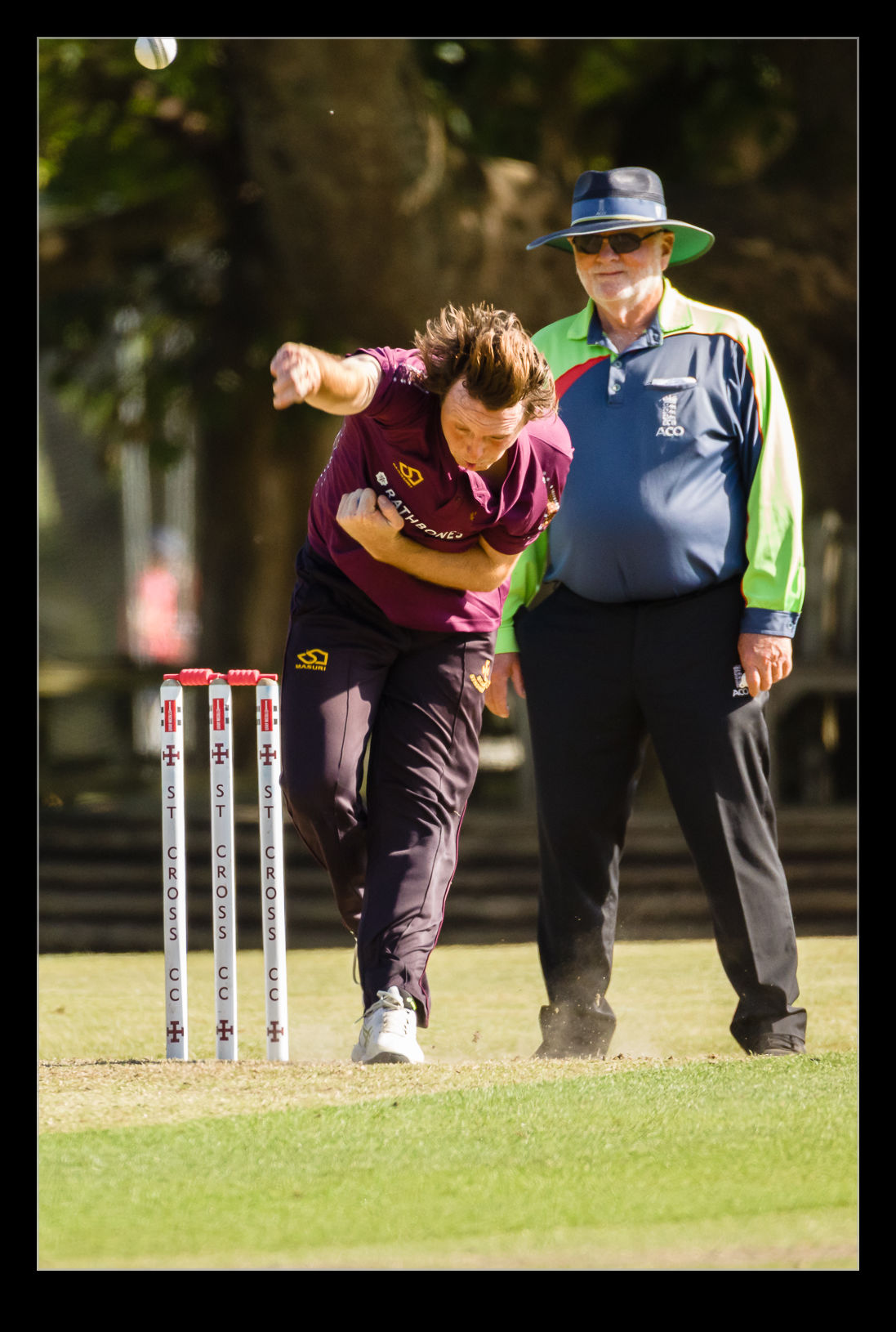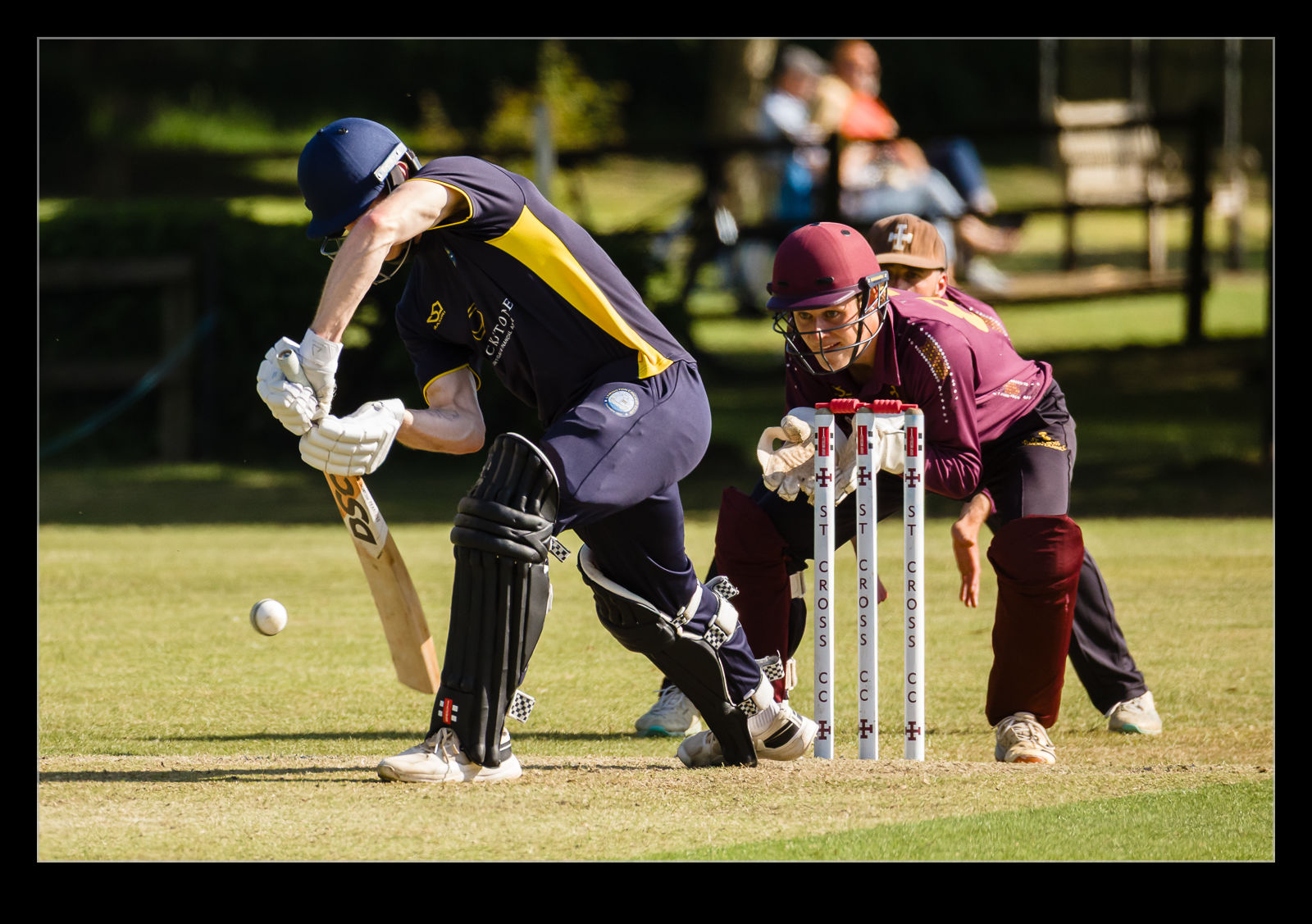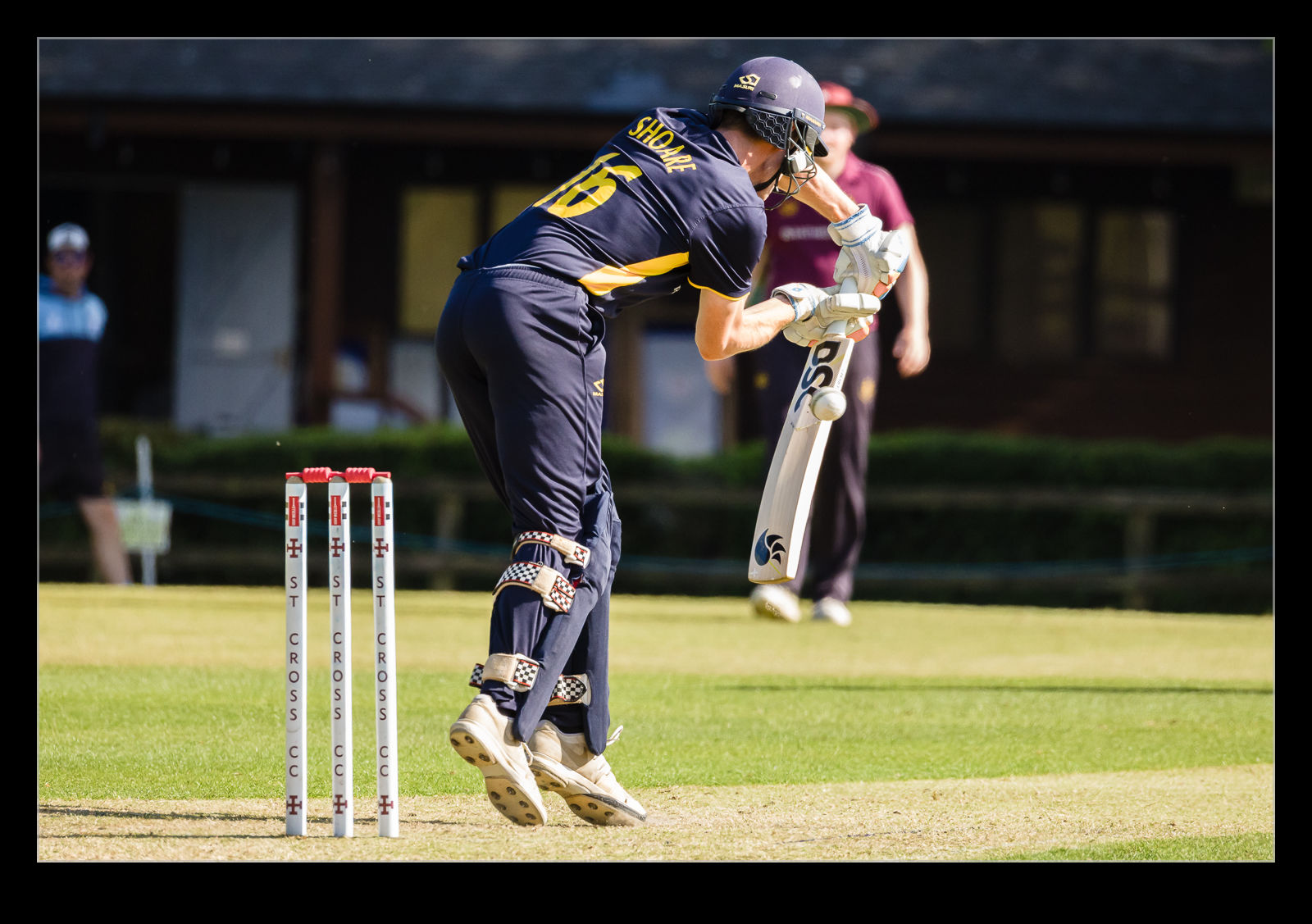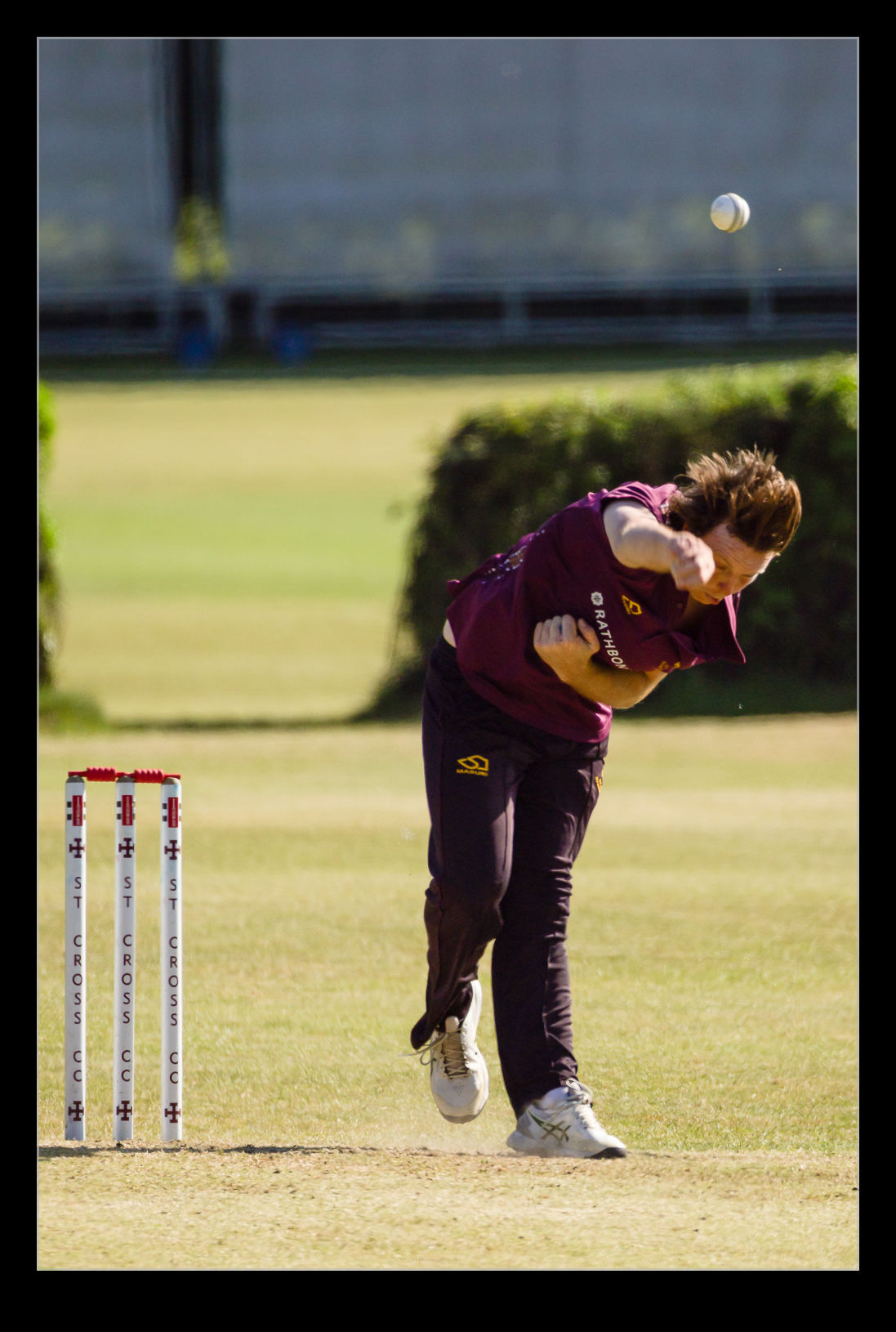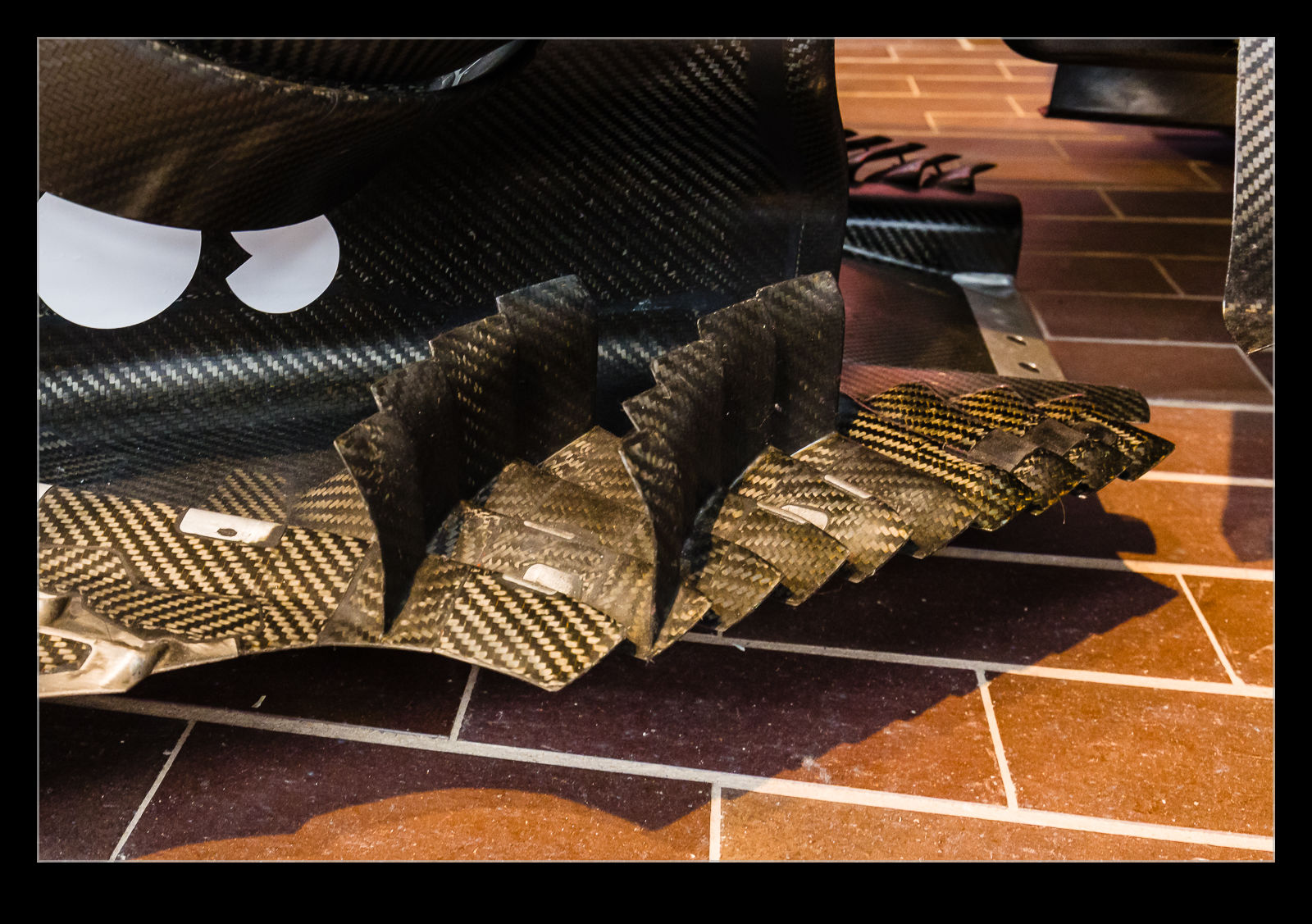 Anyone who follows the details of Formula One is familiar with the endless efforts that go into the design of the aerodynamics of the car. Anyone that knows me knows that I love the aero side of things. The designs will be updated throughout a season to try and maximise the downforce on the car whilst minimising the drag penalty from that downforce. Taking a look at a Williams F1 car at Beaulieu gave a bit of a hint of the tiny details that are included in the design. There is a good chance that this car was not even an operational example and the aero features might not be representative of an actual racing set up, but they are a good approximation of what is involved, and the reality is that it is quite amazing.
Anyone who follows the details of Formula One is familiar with the endless efforts that go into the design of the aerodynamics of the car. Anyone that knows me knows that I love the aero side of things. The designs will be updated throughout a season to try and maximise the downforce on the car whilst minimising the drag penalty from that downforce. Taking a look at a Williams F1 car at Beaulieu gave a bit of a hint of the tiny details that are included in the design. There is a good chance that this car was not even an operational example and the aero features might not be representative of an actual racing set up, but they are a good approximation of what is involved, and the reality is that it is quite amazing.
Category Archives: sport
Generations of F1 Racing Cars
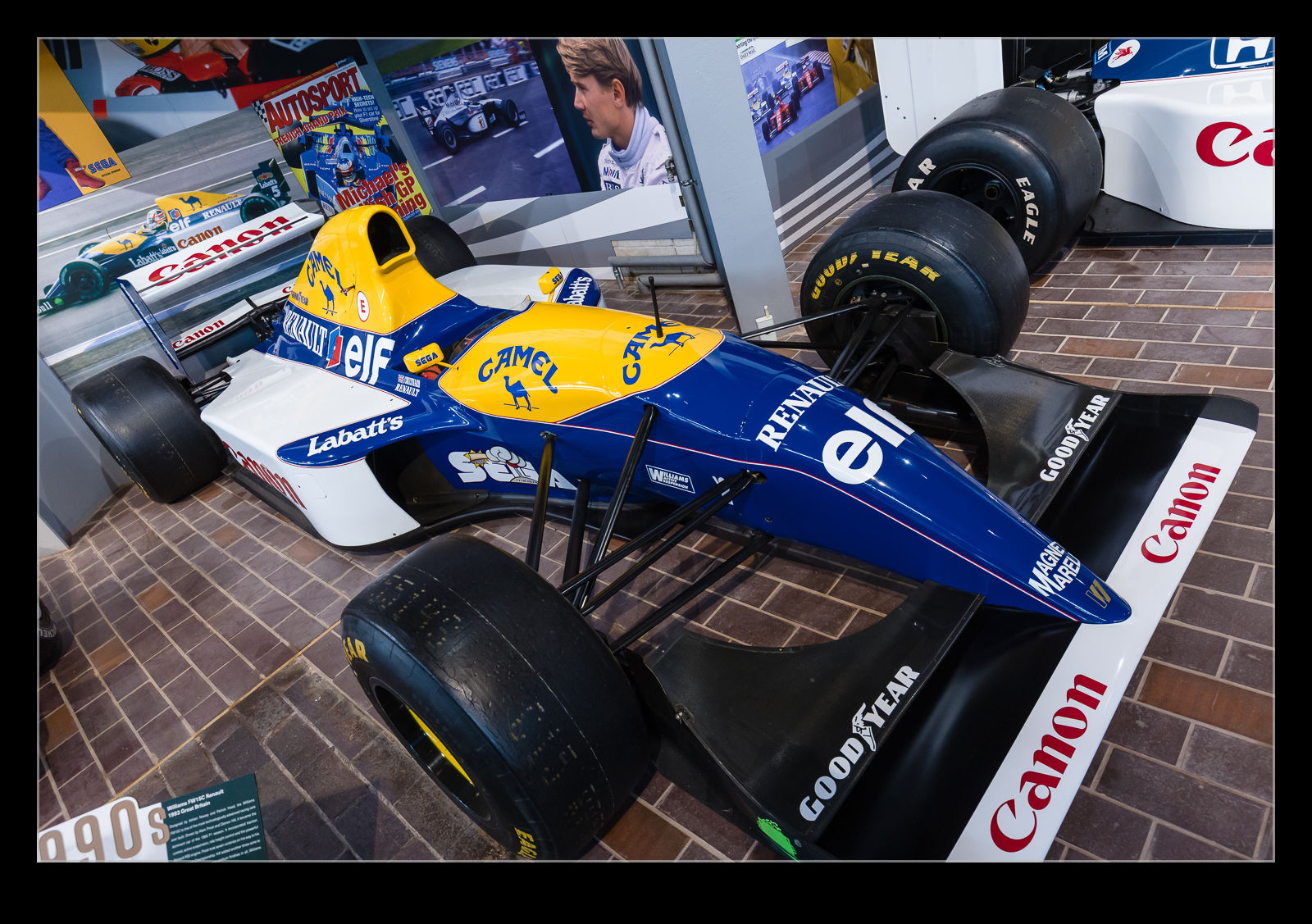 The National Motor Museum at Beaulieu has an F1 exhibit running throughout the summer. There are a number of F1 cars from across the decades on show along with some images and information displays. I imagine that a few competitors were willing to collaborate on this because several of the cars seemed to have the same heritage. For example, the Jaguar is from the team that became Red Bull, so they were probably owned by the same entity and there were some Williams cars too.
The National Motor Museum at Beaulieu has an F1 exhibit running throughout the summer. There are a number of F1 cars from across the decades on show along with some images and information displays. I imagine that a few competitors were willing to collaborate on this because several of the cars seemed to have the same heritage. For example, the Jaguar is from the team that became Red Bull, so they were probably owned by the same entity and there were some Williams cars too.
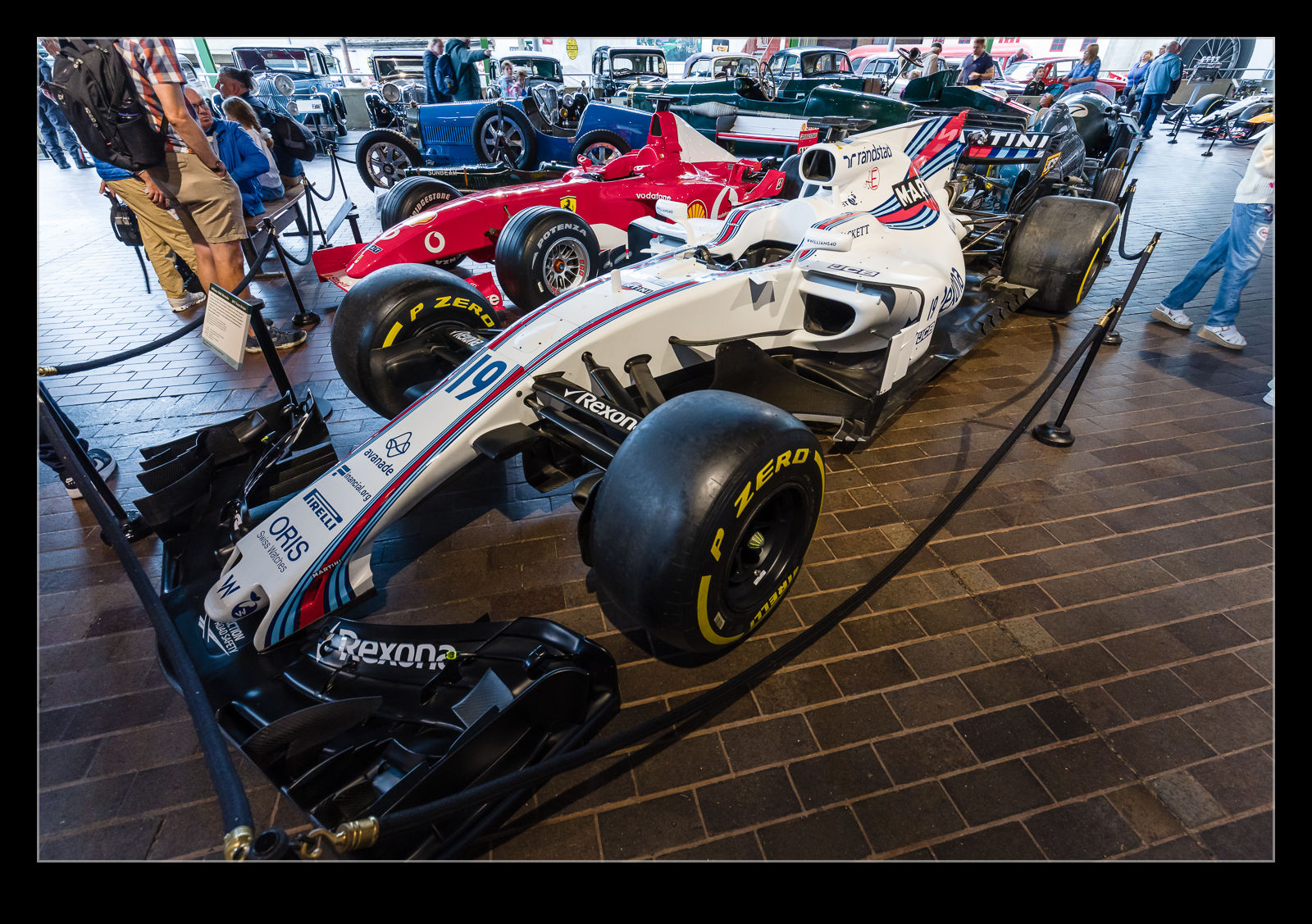 Here are a few shots of the generations of cars that were on display. It is interesting to see how much the size and look of the cars has changed as the rule structures have evolved and the technology has advanced. The 70s cars really do look incredibly flimsy, and it is no surprise that drivers died a lot in those days.
Here are a few shots of the generations of cars that were on display. It is interesting to see how much the size and look of the cars has changed as the rule structures have evolved and the technology has advanced. The 70s cars really do look incredibly flimsy, and it is no surprise that drivers died a lot in those days.
Portsmouth Kite Festival
 We took a trip down to Portsmouth to see the annual kite festival that they hold. It is actually on Southsea Common and attracts both a lot of spectators but also participants from across the continent. I saw performers from Belgium and Switzerland, and I believe there were others. It is a free event on the common, so you are able to walk around and see the different elements at your leisure.
We took a trip down to Portsmouth to see the annual kite festival that they hold. It is actually on Southsea Common and attracts both a lot of spectators but also participants from across the continent. I saw performers from Belgium and Switzerland, and I believe there were others. It is a free event on the common, so you are able to walk around and see the different elements at your leisure.
 We had gone to a kite festival in San Ramon when we lived in California and I was interested to see how they compared. This was a larger event with more to see but the San Ramon event was in a more enclosed area which made it feel more involving. Both had their pluses and minuses. There were two areas enclosed for performers. One was for large shapes that were tethered to a spot and floated above the event. The other was sometimes used for free flying but also was used for performers.
We had gone to a kite festival in San Ramon when we lived in California and I was interested to see how they compared. This was a larger event with more to see but the San Ramon event was in a more enclosed area which made it feel more involving. Both had their pluses and minuses. There were two areas enclosed for performers. One was for large shapes that were tethered to a spot and floated above the event. The other was sometimes used for free flying but also was used for performers.
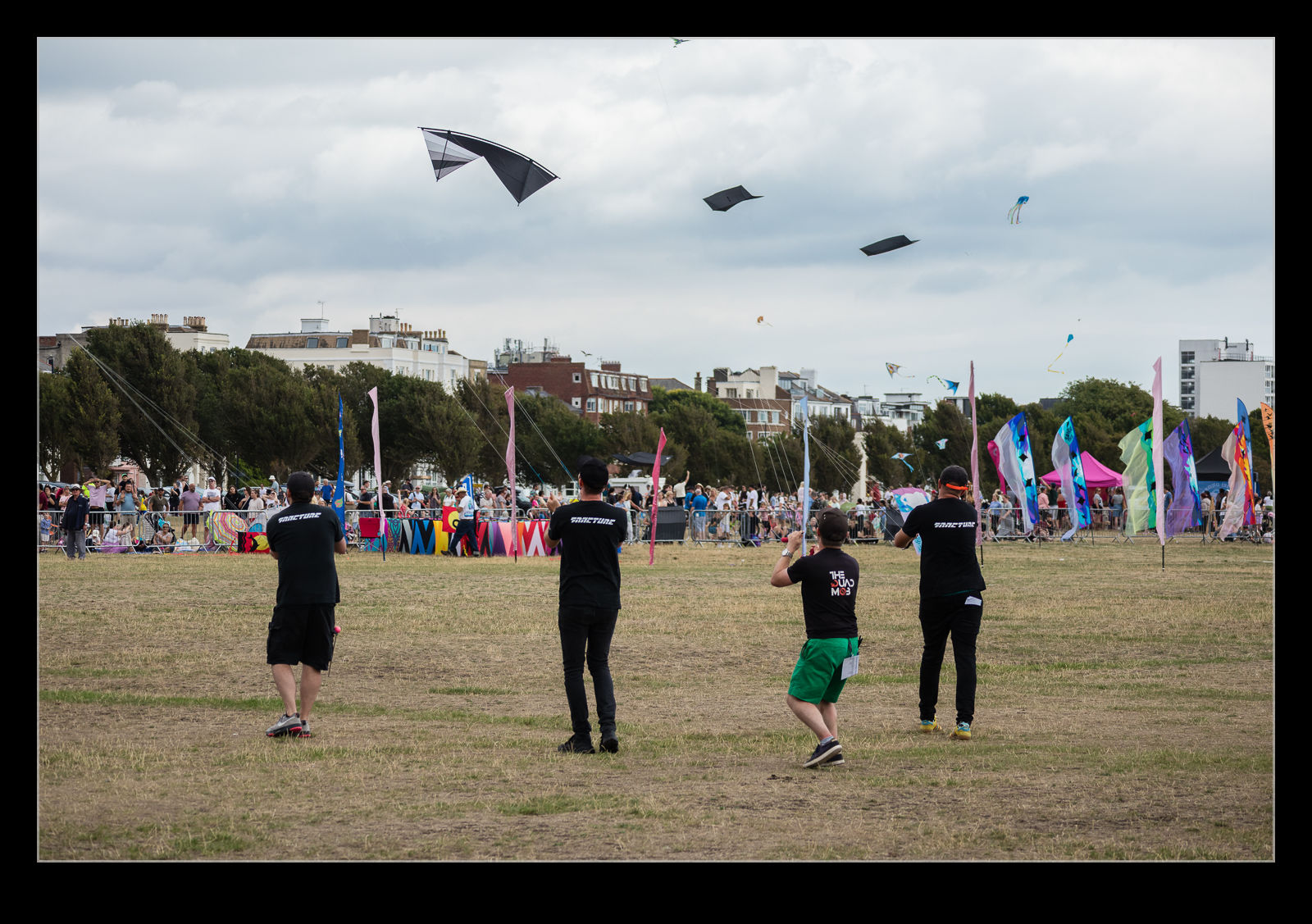 The performers are always worth a watch. Whether it is an individual with a routine or a group of flyers in coordinated displays, the skill and controllability is impressive. I used to do a lot of kite flying and did once fly a Revolution kite a friend of mine had. It was incredibly agile and could be manoeuvred in multiple ways, but it was also super twitchy which made it quite a handful. I see that design is still in use but there are now even more advanced shapes in use. The skill of the teams as they move around each other and overlap their lines to make all sorts of manoeuvres work is so impressive.
The performers are always worth a watch. Whether it is an individual with a routine or a group of flyers in coordinated displays, the skill and controllability is impressive. I used to do a lot of kite flying and did once fly a Revolution kite a friend of mine had. It was incredibly agile and could be manoeuvred in multiple ways, but it was also super twitchy which made it quite a handful. I see that design is still in use but there are now even more advanced shapes in use. The skill of the teams as they move around each other and overlap their lines to make all sorts of manoeuvres work is so impressive.
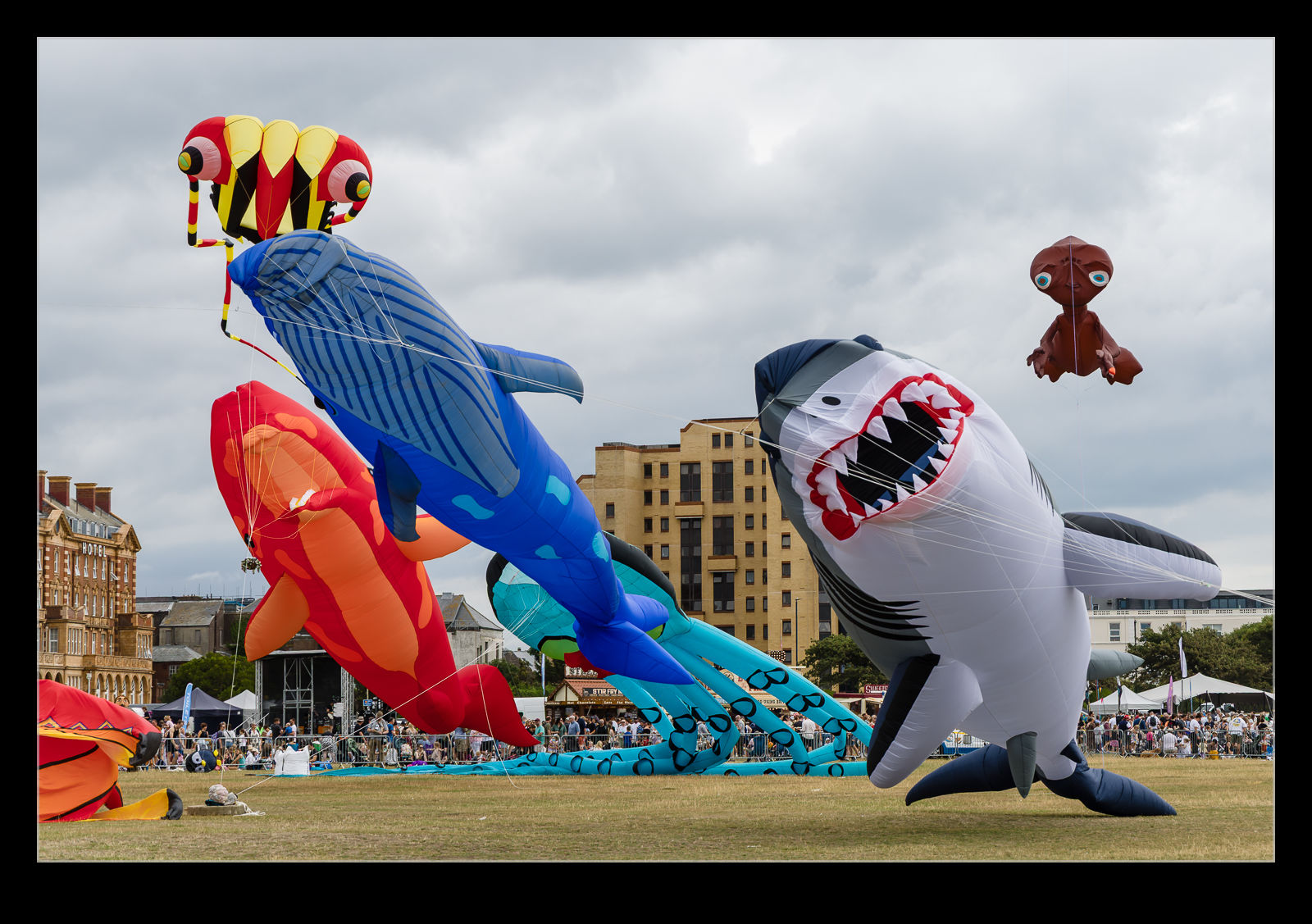 The free flying shapes were so varied in both concept and size. It took me a while to realise that they often had a separate kite flying above them that was used to support them rather than being fully self-supporting. There might be more than one shape on each line. A great white shark and a blue whale were competing for space. Betty Boop was with Felix the Cat. Other creatures that were the result of the imagination of the designers were also up there.
The free flying shapes were so varied in both concept and size. It took me a while to realise that they often had a separate kite flying above them that was used to support them rather than being fully self-supporting. There might be more than one shape on each line. A great white shark and a blue whale were competing for space. Betty Boop was with Felix the Cat. Other creatures that were the result of the imagination of the designers were also up there.
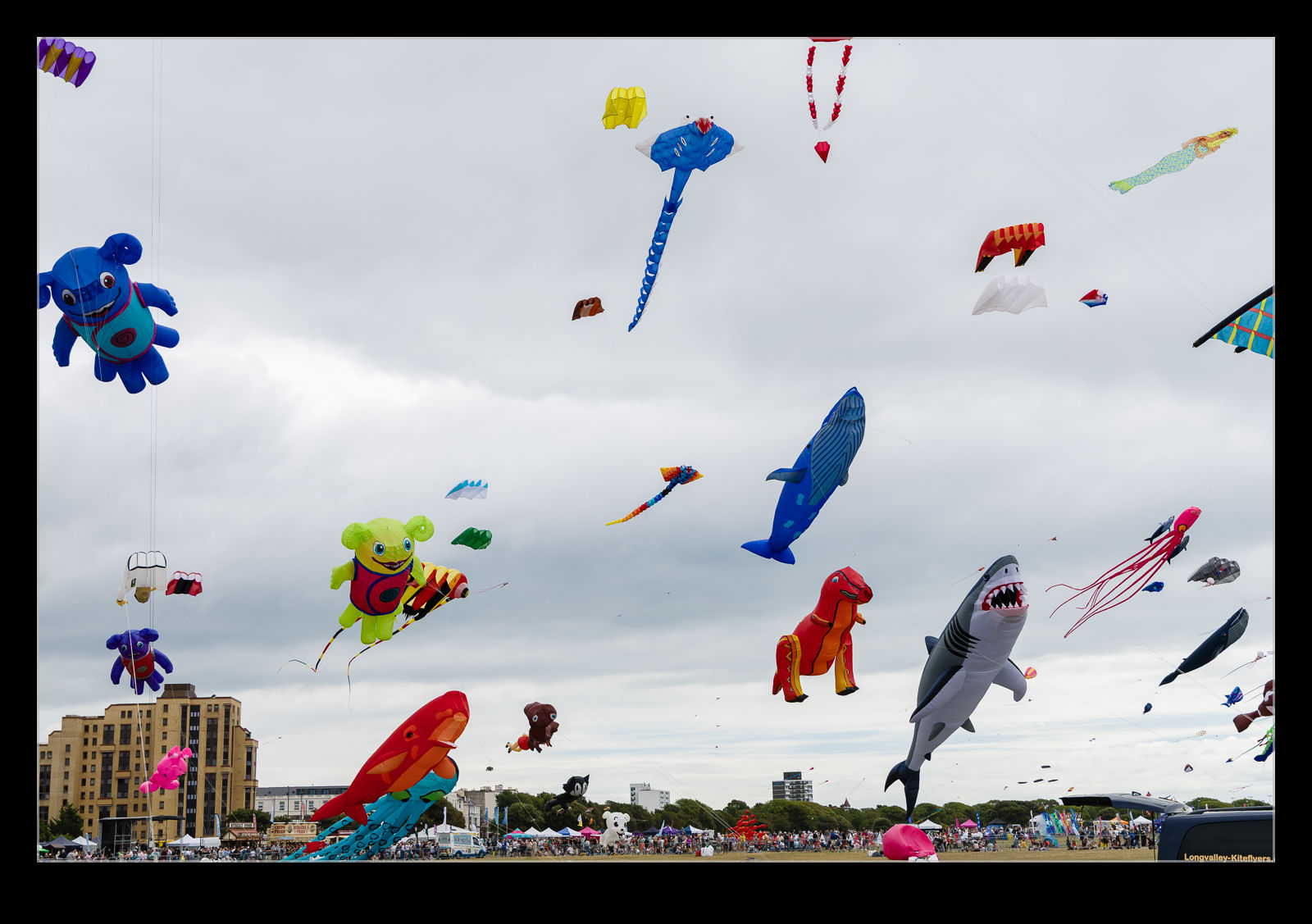 Our favourite was a dragon. It was designed in such a way that the lines to the head were separate from those for the body. Consequently, as it moved back and forth in the breeze, the head would respond to any changes before the body. This made it look more like it was deliberately changing direction. Such a clever piece of design.
Our favourite was a dragon. It was designed in such a way that the lines to the head were separate from those for the body. Consequently, as it moved back and forth in the breeze, the head would respond to any changes before the body. This made it look more like it was deliberately changing direction. Such a clever piece of design.
 The wind was pretty steady on the day (and the conditions rather overcast which had not been the forecast), but it did sometimes drop and also change direction. This meant that some of the shapes would drift out of the arena and over the spectators. This was not an issue until the wind dropped and there were a few occasions when they came down on the people outside the arena. Not a big deal but still rather amusing to watch as the size of these constructions become apparent when next to people. Probably got their attention too.
The wind was pretty steady on the day (and the conditions rather overcast which had not been the forecast), but it did sometimes drop and also change direction. This meant that some of the shapes would drift out of the arena and over the spectators. This was not an issue until the wind dropped and there were a few occasions when they came down on the people outside the arena. Not a big deal but still rather amusing to watch as the size of these constructions become apparent when next to people. Probably got their attention too.
 It was an interesting event and I’m glad we went. It was certainly popular with a ton of people there and a lot of the kids there had acquired their own kites. I bet the kite sellers did good business. I wonder how long they will be played with.
It was an interesting event and I’m glad we went. It was certainly popular with a ton of people there and a lot of the kids there had acquired their own kites. I bet the kite sellers did good business. I wonder how long they will be played with.
Experimenting With Sport and Silly Frame Rates
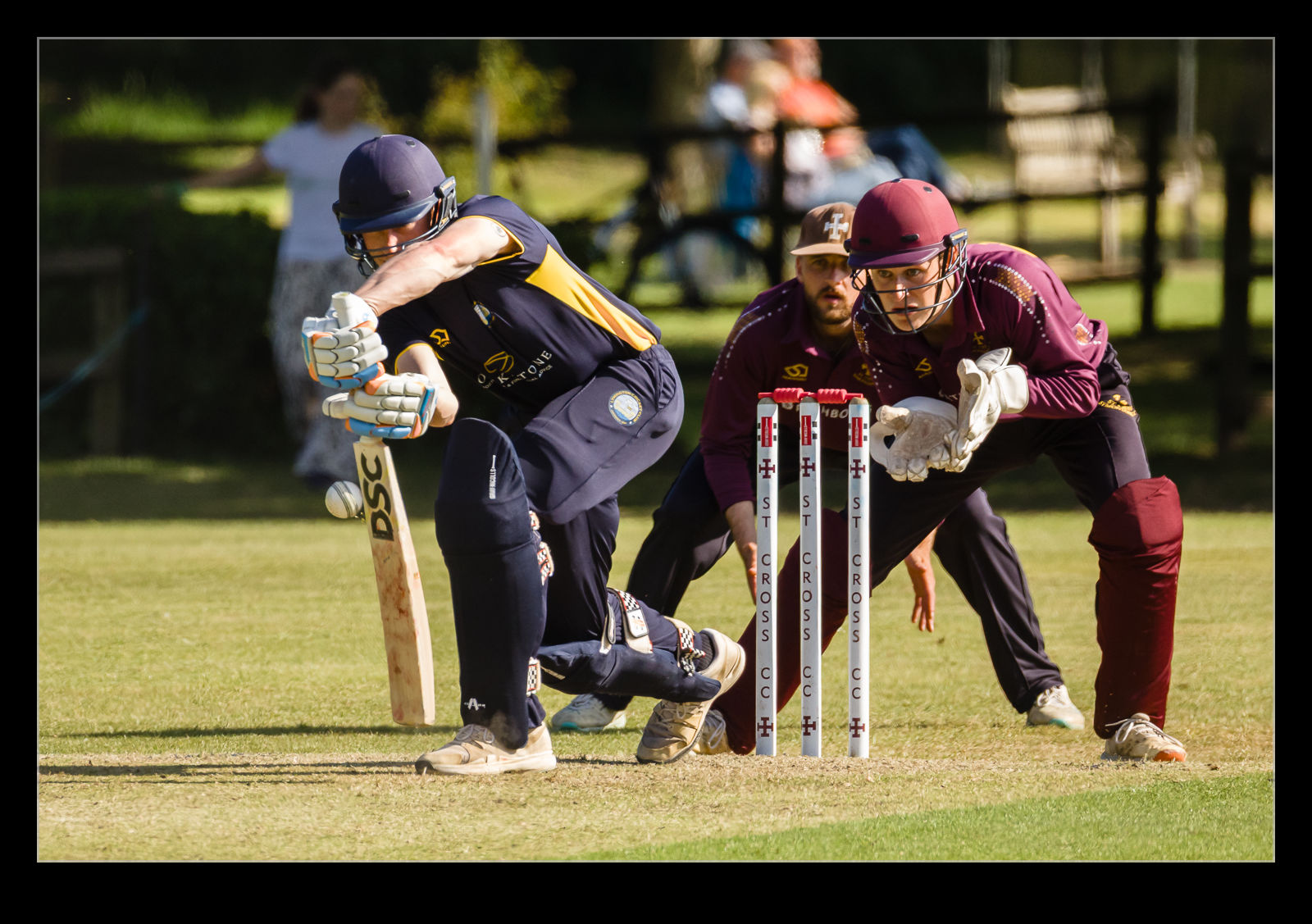 I recently wrote about spending a bit of time at a local cricket club watching a couple of games for a while. I haven’t really photographed cricket much so didn’t have strong ideas about what to try and get with regard to angles and action. I was just playing around, really, to see how things came out. I ramped up the frame rate for some of the shots that the batsmen were making. I was interested to see how I might miss the critical moments and how far the ball had moved between frames.
I recently wrote about spending a bit of time at a local cricket club watching a couple of games for a while. I haven’t really photographed cricket much so didn’t have strong ideas about what to try and get with regard to angles and action. I was just playing around, really, to see how things came out. I ramped up the frame rate for some of the shots that the batsmen were making. I was interested to see how I might miss the critical moments and how far the ball had moved between frames.
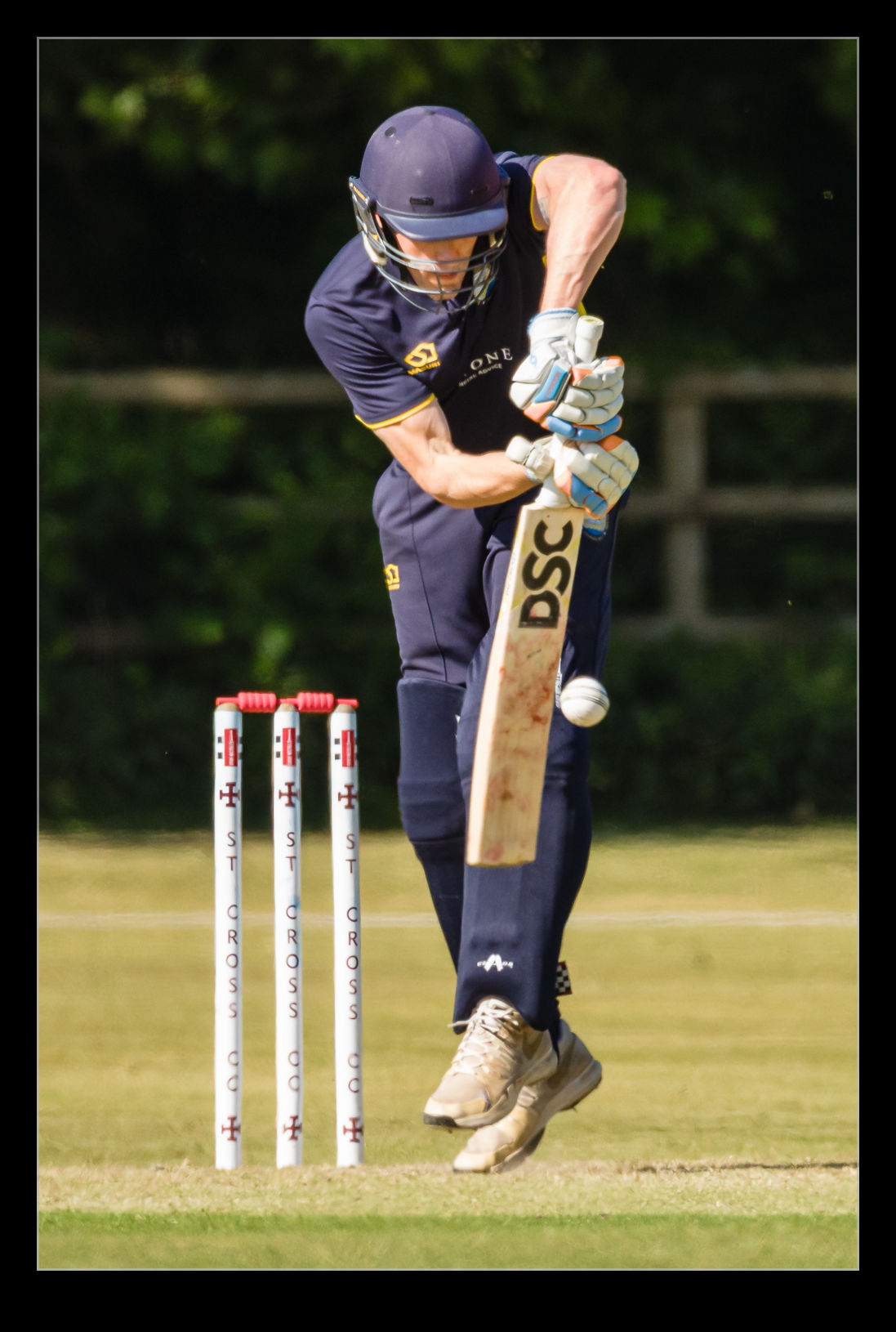 Now, clearly getting the shot is something that technique and skill should deliver. Compensating with the tech is not ideal but I wasn’t trying to prove anything to anyone. Instead, I was just out having fun. Consequently, I decided to use a feature on the R3 that I only occasionally drag out and that is the super fast frame rate of 194fps. This will not use autofocus or auto exposure once the sequence starts, but that isn’t a problem in the 0.2 seconds that it takes to shoot the 50 raw frames that are the limit.
Now, clearly getting the shot is something that technique and skill should deliver. Compensating with the tech is not ideal but I wasn’t trying to prove anything to anyone. Instead, I was just out having fun. Consequently, I decided to use a feature on the R3 that I only occasionally drag out and that is the super fast frame rate of 194fps. This will not use autofocus or auto exposure once the sequence starts, but that isn’t a problem in the 0.2 seconds that it takes to shoot the 50 raw frames that are the limit.
 It is amazing that, even with such a high frame rate, the ball still can move quite a distance between shots. You do end up with a ton of frames that are going straight in the bin. Since the ball either hasn’t arrived in frame or it has gone. That is a pretty easy process of culling of course. You also never know whether a given delivery is going to result in anything. You can get 50 frames as the batsman lets the ball through. Those are even easier to cull! Did I get anything I really liked? No, to be honest, I wasn’t too excited by any of them. However, it has got me thinking about what would make for a better shot. I shall have to work on that and head back to see if I can improve things.
It is amazing that, even with such a high frame rate, the ball still can move quite a distance between shots. You do end up with a ton of frames that are going straight in the bin. Since the ball either hasn’t arrived in frame or it has gone. That is a pretty easy process of culling of course. You also never know whether a given delivery is going to result in anything. You can get 50 frames as the batsman lets the ball through. Those are even easier to cull! Did I get anything I really liked? No, to be honest, I wasn’t too excited by any of them. However, it has got me thinking about what would make for a better shot. I shall have to work on that and head back to see if I can improve things.
Time for Some Local Cricket
 The onset of summer in the UK got me thinking of cricket. It is true that the Pacific Northwest has quite a cricket scene that has developed – principally as a result of the many people that have moved there from countries where cricket is a big deal. However, I never really spent any time checking it out while we were there. However, village cricket is a quintessential element of the UK and I thought I should go and see one of the local clubs in Winchester.
The onset of summer in the UK got me thinking of cricket. It is true that the Pacific Northwest has quite a cricket scene that has developed – principally as a result of the many people that have moved there from countries where cricket is a big deal. However, I never really spent any time checking it out while we were there. However, village cricket is a quintessential element of the UK and I thought I should go and see one of the local clubs in Winchester.
 I went to see St Cross Symondians First XI play. Even the name seems suitable for an English country game. I didn’t time it very well as I wandered up just as they were breaking for tea. Fortunately, there was a second game on the adjoining pitch, so I watched that for a bit from the other side of the hedge. Those players were in traditional whites, which fitted the traditional image I had in mind. When the main game resumed, they were playing in dark colours with a white ball. I have no idea how the decision gets made. With a lot of trees around the ground, maybe the visibility is an issue. If anyone knows, please let me know.
I went to see St Cross Symondians First XI play. Even the name seems suitable for an English country game. I didn’t time it very well as I wandered up just as they were breaking for tea. Fortunately, there was a second game on the adjoining pitch, so I watched that for a bit from the other side of the hedge. Those players were in traditional whites, which fitted the traditional image I had in mind. When the main game resumed, they were playing in dark colours with a white ball. I have no idea how the decision gets made. With a lot of trees around the ground, maybe the visibility is an issue. If anyone knows, please let me know.
 I walked around the pitch to watch the play from various angles for a while. I ended up experimenting with some different photo techniques while I was there because it was a sunny weekend afternoon and I was in no hurry. I will post separately about some of what I tried. For today, I just wanted to share some shots of the larger scene. Maybe next time I’ll take a chair, get a pint from the clubhouse and sit watching the game for longer. It has also got me thinking about going to watch some professional games, but we shall see.
I walked around the pitch to watch the play from various angles for a while. I ended up experimenting with some different photo techniques while I was there because it was a sunny weekend afternoon and I was in no hurry. I will post separately about some of what I tried. For today, I just wanted to share some shots of the larger scene. Maybe next time I’ll take a chair, get a pint from the clubhouse and sit watching the game for longer. It has also got me thinking about going to watch some professional games, but we shall see.
Almost Paragliding on the Shore
 Another post from my time on the shoreline at Mukilteo. I was working away on the laptop and a bit oblivious to whatever was outside the car when a flash of color caught my eye. Looking up, a guy was standing across the lot with a paraglider inflated above him. I have no idea what his plan was since he was about as low as he could be and launching somewhere seemed unlikely. Maybe he was testing something. Whatever the reason, this was one of the more unlikely things I have seen in a parking lot!
Another post from my time on the shoreline at Mukilteo. I was working away on the laptop and a bit oblivious to whatever was outside the car when a flash of color caught my eye. Looking up, a guy was standing across the lot with a paraglider inflated above him. I have no idea what his plan was since he was about as low as he could be and launching somewhere seemed unlikely. Maybe he was testing something. Whatever the reason, this was one of the more unlikely things I have seen in a parking lot!
Getting Eight to Work Together
 I was down by the lake at Kenmore on my usual hunt for floatplanes but things were pretty quiet – at least on the aviation front. On the water, I saw a bunch of rowers out training. I don’t know whether they were from the university or a local club. Several boats were out including some eights. The coaching staff were guiding them around but, when they get to the top of the lake, it seems like a time for them to rest and turn around. I imagine the process of getting eight people to row in unison is quite tricky. I don’t know whether they start on smaller boats to get the hang of things before moving up to the eight or not. These crews seemed to be working pretty well together.
I was down by the lake at Kenmore on my usual hunt for floatplanes but things were pretty quiet – at least on the aviation front. On the water, I saw a bunch of rowers out training. I don’t know whether they were from the university or a local club. Several boats were out including some eights. The coaching staff were guiding them around but, when they get to the top of the lake, it seems like a time for them to rest and turn around. I imagine the process of getting eight people to row in unison is quite tricky. I don’t know whether they start on smaller boats to get the hang of things before moving up to the eight or not. These crews seemed to be working pretty well together.
An Aero Engine in a Boat
 The hydroplane races at Seafair were not much of a focus for me although I have posted some images of qualifying runs. However, one of the boats really caught my ear when it was out on the course. The noise it made led me to think it might be an older boat powered by an old aero engine. Looking at the images I got of it, that would seem to be the case as the front of the hull seems to be dominated by a large engine. Don’t know what type it is and maybe some of you are familiar with these boats generally or this boat specifically. Was it a competitor or was it out as a historic boat as part of the event?
The hydroplane races at Seafair were not much of a focus for me although I have posted some images of qualifying runs. However, one of the boats really caught my ear when it was out on the course. The noise it made led me to think it might be an older boat powered by an old aero engine. Looking at the images I got of it, that would seem to be the case as the front of the hull seems to be dominated by a large engine. Don’t know what type it is and maybe some of you are familiar with these boats generally or this boat specifically. Was it a competitor or was it out as a historic boat as part of the event?
Hydroplane Qualifying
 Seafair is mainly about the airshow for me. However, there is a lot more to it than that and the hydroplane races have long been a key part of proceedings. I didn’t worry too much about the races as I was only planning on getting to the lake in time for the flying. I did have an easy journey and got to the lakeshore earlier than expected and there appeared to be some qualifying underway on the water. I was not well positioned to see the course, but I could still see them as they ran around the southern part of the track. Consequently, I got a few shots and here are some pretty serious look hydroplanes.
Seafair is mainly about the airshow for me. However, there is a lot more to it than that and the hydroplane races have long been a key part of proceedings. I didn’t worry too much about the races as I was only planning on getting to the lake in time for the flying. I did have an easy journey and got to the lakeshore earlier than expected and there appeared to be some qualifying underway on the water. I was not well positioned to see the course, but I could still see them as they ran around the southern part of the track. Consequently, I got a few shots and here are some pretty serious look hydroplanes.
A Detailed Tour of a Clipper Race Boat

In a previous post I discussed the arrival of the Clipper Round the World boats in Seattle. In that post, I mentioned that I got it wrong about being able to go on the boats to have a look around. However, I did end up having a second go at looking at the boats and this time, it was a success. The boat that was open for visitors was named Qingdao. One of the crew showed us around both up on deck and down below.

When looking at these boats from the outside, they look like pretty sizable craft. However, when you get down below, it is instantly apparent how limited the space is. There is a lot of space taken up by the sail locker and the engine room. Then you have a small galley area and the navigation station. There are two small heads – no showers, though. The remainder of the space is for the crew of 22 to squeeze in to. This is not a luxurious excursion. (We were told that, had we been on a couple of days before, the odor would still have been pretty ripe. A long time at sea does not make for great hygiene!)

I had decided to take my widest zoom for the visit and I was glad I did that. Everything was so confined, it really needed a wide angle to get any shots. Even maneuvering through the hull while docked required a bit of effort. I can’t imagine what it would be like when heeled over at 45 degrees while punching through a Southern Ocean storm. They say you learn a lot about yourself in these races and I don’t doubt it. I’d probably learn I am not cut out for serious adventures!

The galley was interesting. Aside from the stabilized hob, all of the cans were stripped of labels and marked up with their contents. Everything gets wet so labels fall off rapidly. You need to prep to make sure you can identify the food. The cans do corrode in the salt water. Apparently, it’s not unknown to open a can and find nothing inside it because it has already leaked away from a corrosion hole!

The boats were really interesting to see. The crews spend a lot to be on this voyage and they are definitely getting an adventure. I hope they have fun ultimately and I like to see what they have done but I won’t be signing up anytime soon.







